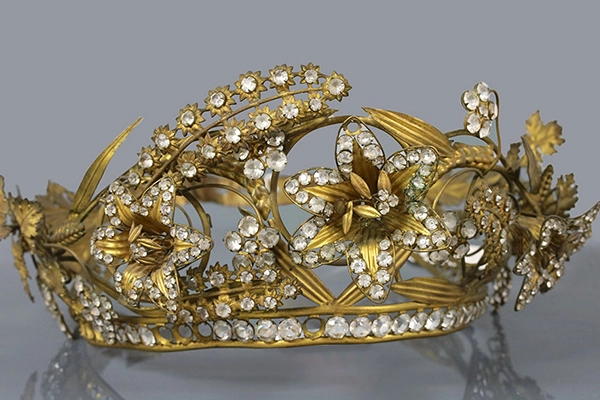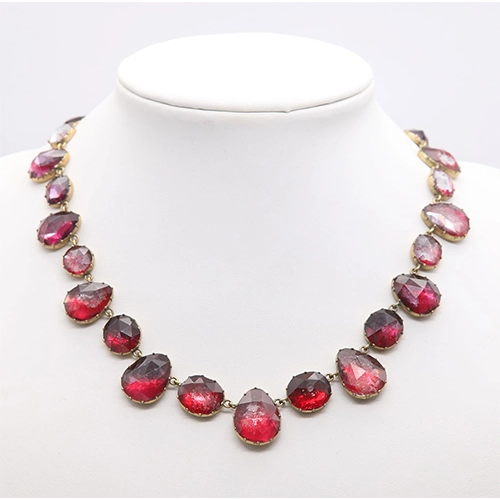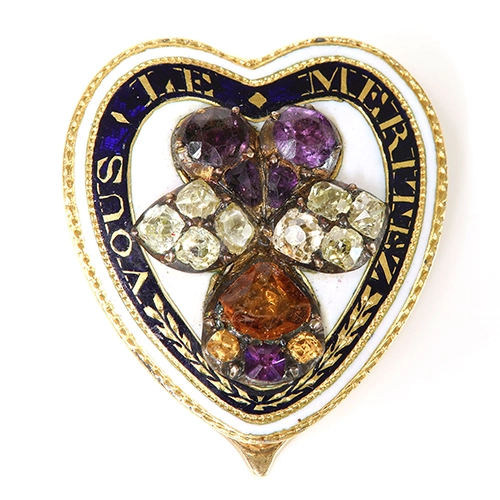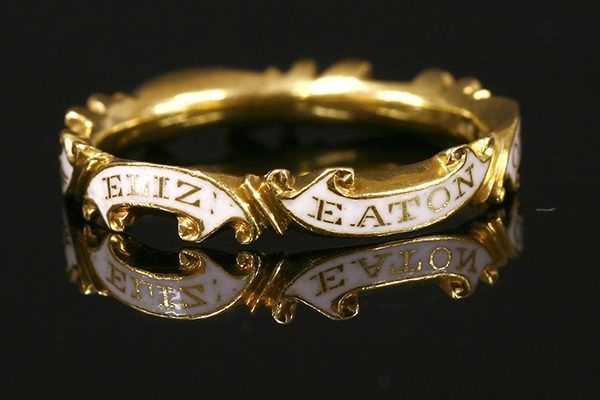17 August 2022
Why collectors love Georgian costume jewellery and the thrill of the chase
6 minutes
(Image: A Georgian carved ‘forget me not’ sardonyx memorial pendant, with two later Victorian pieces. Lot 12, Fine Jewellery and Watches 11th June 2019. Sold for £182 including buyer’s premium.)
Hidden messages and stories behind items of Georgian jewellery attract collectors who love to explore the history of sentimental pieces, Sworders’ jewellery specialist Catrin Jones tells Private Clients Director Julie Webb.
The Georgian era spanned more than 100 years (1714-1830), a period of prosperity and Romanticism. Artist Thomas Gainsborough’s love of landscape painting made him a forerunner of the Romantic movement while Beethoven was introducing new feeling into music. The arts were patronised by royalty, with King George I indulging his love of opera.
The Georgians were serious about fashion too, hugely influenced by aristocrats returning from their grand tours of Europe. Men and women favoured fine fabrics and silks with ornate detailing; ribbons, ruffles and feathers were all adornments alongside plenty of jewellery.
For the privileged, balls and soirees continued late into the night as improvements in manufacture produced longer burning and brighter candles. A divide between day and evening wear marked a new chapter in fashion and jewellery history.
|
|
(Image: A Regency gilt metal and paste tiara, c.1820. Lot 9, Fine Jewellery and Watches 17th November 2020. Sold for £910 including buyer’s premium)
Georgian jewellery stands out with quality items, hand-made by skilled artisans. Styles were ornate with intricate metalwork techniques such as repoussé – the hammering of metal into detailed designs and cannetille, a method of working gold wire to make it look woven.
Pearls, sapphires, rubies, topaz and garnets were popular, with rubies and pearls becoming a particularly fashionable combination. Gemstones in this era were often set with a thin metal foil backing, which served the purpose of both improving the reflective quality and intensifying the colour of the gemstone.
Paste, the cutting of glass to mimic diamonds and other gemstones, was an early form of costume jewellery. Paste is a type of heavy, flint glass with a high refractive index and strong dispersion, meaning that the paste stones would glitter and sparkle just like diamonds and other gemstones –especially so when worn to those candlelit balls.
|
|
(Image: Queen Anne style gilt metal foil backed graduated paste necklace c.1760. Sold for £2,210 including buyer’s premium at Sworders’ Fine Jewellery & Watches sale June 28, 2022)
Even Marie Antoinette had her own paste jewellers; it was not just for those unable to afford real gems. Nowadays, sought-after Georgian paste jewellery can fetch sums that rival fine jewellery. For example, a paste necklace, c.1760, sold in our recent fine jewellery & watches sale on June 28, 2022 for £2,210.
Another fantastic piece in this sale was a gold heart-shaped brooch with an amethyst, citrine and diamond-set pansy motif in the centre. The word ‘pansy’ comes from the French ‘penser’, to think, and so the pansy was a common motif for ‘I am always thinking of you’. Around the outside of the brooch is enameled ‘vous le meritez’ meaning ‘you deserve it’ – so the brooch may have been given to a woman on her wedding day or perhaps after the birth of a child. It is this intrigue that draws in curious buyers.
|
|
(Image: Late Georgian amethyst, citrine, diamond and enamel heart-shaped clip brooch. Sold for £3,900 including buyer’s premium at Sworders’ Fine Jewellery & Watches sale June 28, 2022)
Lover’s Eye rings are particularly sought-after. They were first recorded in Britain in 1773, but made popular in 1784 when the Prince of Wales (later George IV) wooed Maria Fitzherbert – a widowed Catholic he was forbidden to marry. He sent Maria a painting of his eye, and after they were married in a secret ceremony, Fitzherbert returned the gesture.
A fashion for exchanging miniature eye portraits as love tokens began as secret lovers exchanged gifts knowing that only the recipient would know whose eye it was.
These rings do not come up often so they sell well, particularly if they are in an original state, and can fetch £3,000-£5,000.
Memorial rings
The custom of bequeathing a ring wasn’t started in the Georgian era; this kind of remembrance dates from the Middle Ages. By the late 16th century memorial rings had become an accepted social statement but grew in importance during the late 18th century when the provision of funerary articles was considered to represent high status.
Money to create this jewellery was left in the will of the deceased and included a description of the ring’s design with a list of close friends and loved ones who should receive a ring. The rings were worn by the recipients as a way to remember they were loved and respected by the deceased. These rings often had scrolling banner designs with words etched in the enamel, such as a name or date of death.
Buyers will notice that by the mid-18th century mourning rings began to undergo significant change. Memento mori iconography gave way to more delicate designs and sentimental messaging with a scroll or wavy band in black enamel to represent an adult or white for a child or adolescent. Rings also began to incorporate the hair of the deceased, mounted under a rock crystal bezel.
Collectors love memorial rings as they offer a story attached to the jewellery and the person’s life can often be traced to add more interest, and often value, to the item. It was not uncommon for these rings to be melted down, so they are no longer hugely common – and because enamel was used there is a limited number of items in excellent condition as enamel is prone to being chipped and scratched. Prices for these rings range from £750-£1,500 but can fetch more if the deceased is a person of historical interest.
|
|
(Image: A Georgian white enamel memorial ring, reading ‘Eliz: Eaton’. Sold by Sworders for £1,365 including buyer’s premium in November 2019)
Pieces of memorial jewellery often contained hair of the deceased, either woven or plaited and set under a glazed panel, or intricately arranged in the forms of curls, Prince-of-Wales’ feathers, wheatsheaves and urns. Another type of hairwork found in memorial jewellery is that of ‘palette work’, in which single strands of hair would be cut to tiny lengths and arranged on an adhesive background to form a picture or landscape.
It was often the women in the bereaved family who weaved the hair as a labour of love. While some people find this a little too macabre for their taste, there are collectors fascinated by this art.
A buoyant market
The Georgian jewellery market, particularly sentimental items, is buoyant and prices have been rising over the last 10 years for several reasons; they are beautifully made, attractive in design and buyers find memorial items with a message or hair intriguing and enjoy researching pieces to find out more about the deceased and connect to that period.
Furthermore, there are far fewer Georgian pieces, than say Victorian jewellery, for reasons including the French Revolution when wearing jewellery was punishable by death. In France, no fine jewellery was made at that time and what did exist was broken down for the gems or melted down. The scarcity of these pieces only adds to the thrill of the chase for collectors.
Insuring your jewellery
Whether you have an extensive collection or a single item, remember the importance of regular valuations.
Insurers recommend that you obtain a jewellery valuation at least every five years, preferably three in today’s market. But check your schedule and policy wording for specific requirements.
Insurers will require any valuation to be for “insurance purposes” and for retail value. You should also consider how you would replace your jewellery in the event of a loss. Would you want a brand new replacement with a modern equivalent (New Replacement Value) or would you prefer an antique replacement (Antique Replacement Value)? Ensure the items are photographed, kept in good condition and your documentation is in a safe place to help in the event of a claim. It’s a good idea to send a copy of your valuations to your broker, whether or not the insurer requires it.
Aston Lark are specialists in finding the right jewellery insurance solution, something you should never have to do on your own. We understand the value of a good policy and will help you protect your passion and investment. To find out how, please read our article on why you need a broker for your jewellery insurance.
And finally – remember to have your valuables checked by a jeweller as that clasp or a setting can easily fail.
To speak to Aston Lark about insuring your jewellery, call 020 8256 4901 or email private.clients@howdeninsurance.co.uk
About Catrin Jones
Catrin joined the jewellery industry at 14, working at a local jeweller on Saturdays and in her school holidays. She was immediately bitten by the jewellery bug and, post university, having completed her qualifications in gemology and diamond grading, she began working as a jewellery valuer.
Catrin attributes her love of jewellery to two sources; firstly, the natural materials – the precious metals, gemstones and diamonds – and secondly, the human innovation and creativity that turns these materials into miniature works of art.
Next auction
Sworders Fine Art Auctioneers’ next jewellery auction is on August 31. Visit sworders.com




